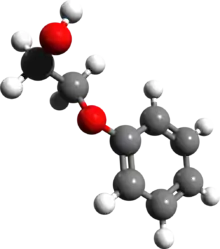Phenoxyethanol
Phenoxyethanol is a germicidal and germistatic glycol ether, phenol ether, and aromatic alcohol often used together with quaternary ammonium compounds.
 | |
 | |
| Names | |
|---|---|
| IUPAC name
2-Phenoxyethanol | |
| Other names
Phenoxyethanol Ethylene glycol monophenyl ether Phenoxytolarosol Dowanol EP / EPH Protectol PE Emery 6705 Rose ether 1-Hydroxy-2-phenoxyethane β-hydroxyethyl phenyl ether Phenyl cellosolve | |
| Identifiers | |
3D model (JSmol) |
|
| ChEBI | |
| ChEMBL | |
| ChemSpider | |
| ECHA InfoCard | 100.004.173 |
PubChem CID |
|
| UNII | |
CompTox Dashboard (EPA) |
|
| |
| |
| Properties | |
| C8H10O2 | |
| Molar mass | 138.166 g·mol−1 |
| Appearance | Colorless oily liquid |
| Odor | faint rose-like |
| Density | 1.102 g/cm3 |
| Melting point | −2 °C (28 °F; 271 K) |
| Boiling point | 247 °C (477 °F; 520 K) |
| 26 g/kg | |
| Solubility | Chloroform, Alkali, diethyl ether: soluble |
| Solubility in peanut oil | slightly |
| Solubility in olive oil | slightly |
| Solubility in acetone | miscible |
| Solubility in ethanol | miscible |
| Solubility in glycerol | miscible |
| Vapor pressure | 0.001 kPa (0.00015 psi) |
| Thermal conductivity | 0.169 W/(m⋅K) |
Refractive index (nD) |
1.534 (20 ℃) |
| Hazards | |
| Main hazards | Harmful if swallowed Causes serious eye irritation |
| GHS pictograms |  |
| GHS Signal word | Warning |
| NFPA 704 (fire diamond) | |
| Flash point | 126 °C (259 °F; 399 K) |
| 430 °C (806 °F; 703 K) | |
| Lethal dose or concentration (LD, LC): | |
LD50 (median dose) |
1850 mg/kg (rat, oral) |
| Related compounds | |
Related compounds |
phenetole |
Except where otherwise noted, data are given for materials in their standard state (at 25 °C [77 °F], 100 kPa). | |
| Infobox references | |
Use
Phenoxyethanol is used as a perfume fixative; an insect repellent; an antiseptic; a solvent for cellulose acetate, dyes, inks, and resins; a preservative for pharmaceuticals, cosmetics and lubricants; an anesthetic in fish aquaculture; and in organic synthesis.
Phenoxyethanol is an alternative to formaldehyde-releasing preservatives.[4] In Japan and the European Union, its concentration in cosmetics is restricted to 1%.[5]
Production
Phenoxyethanol is produced by the hydroxyethylation of phenol (Williamson synthesis), for example, in the presence of alkali-metal hydroxides or alkali-metal borohydrides.[1]
Efficacy
Phenoxyethanol is effective against gram-negative and gram-positive bacteria, and the yeast Candida albicans.[6]
| Aromatic alcohol | Concentration (%) | Contact time (minutes) | |||
|---|---|---|---|---|---|
| Escherichia coli | Pseudomonas aeruginosa | Proteus mirabilis | Staphylococcus aureus | ||
| Benzyl alcohol | 1 | >30 | >30 | >30 | >30 |
| Phenethyl alcohol | 1.25 | 2.5 | 2.5 | 2.5 | >30 |
| 2.5 | 2.5 | 2.5 | 2.5 | 5 | |
| Phenoxyethanol | 1.25 | 15 | 2.5 | 2.5 | >30 |
| 2.5 | 2.5 | 2.5 | 2.5 | >30 | |
Safety
Phenoxyethanol is a vaccine preservative and potential allergen, which may result in a nodular reaction at the site of injection.[8] It reversibly inhibits NMDAR-mediated ion currents.[9] Ingestion may cause central nervous system and respiratory depression, vomiting and diarrhea in infants, particularly when combined with chlorphenesin.[10]
References
- Helmut Fiege; Heinz-Werner Voges; Toshikazu Hamamoto; Sumio Umemura; Tadao Iwata; Hisaya Miki; Yasuhiro Fujita; Hans-Josef Buysch; Dorothea Garbe (2007). "Phenol Derivatives". Ullmann's Encyclopedia of Industrial Chemistry. Weinheim: Wiley-VCH. doi:10.1002/14356007.a19_313.
- Commission, British Pharmacopoeia (2009), "Phenoxyethanol", British Pharmacopoeia, 2, ISBN 978-0-11-322799-0
- David R. Lide, ed. (2010), CRC Handbook of Chemistry and Physics (90th ed.), CRC Press
- Wineski LE, English AW (1989). "Phenoxyethanol as a nontoxic preservative in the dissection laboratory". Acta Anat (Basel). 136 (2): 155–8. doi:10.1159/000146816. PMID 2816264.
- Tokunaga H, Takeuchi O, Ko R, Uchino T, Ando M (2003). "市販化粧水中のフェノキシエタノールおよびパラベン類の分析法に関する研究" [Studies for analyzing phenoxyethanol and parabens in commercial lotions] (PDF). Kokuritsu Iyakuhin Shokuhin Eisei Kenkyūjo Hōkoku (in Japanese) (121): 25–9. PMID 14740401.
- Lowe I, Southern J (1994). "The antimicrobial activity of phenoxyethanol in vaccines". Lett Appl Microbiol. 18 (2): 115–6. doi:10.1111/j.1472-765X.1994.tb00820.x. PMID 7764595.
- Hans-P. Harke (2007), "Disinfectants", Ullmann's Encyclopedia of Industrial Chemistry (7th ed.), Wiley, pp. 1–17, doi:10.1002/14356007.a08_551
- M. H. Beck; S. M. Wilkinson (2010), "Contact Dermatitis: Allergic", in Tony Burns; Stephen Breathnach; Neil Cox; Christopher Griffiths (eds.), Rook's Textbook of Dermatology, 2 (8th ed.), Wiley-Blackwell, p. 26.46, ISBN 978-1-4051-6169-5
- Schmuck G, Steffens W, Bomhard E (July 2000). "2-Phenoxyethanol: a neurotoxicant?". Archives of Toxicology. 74 (4–5): 281–7. doi:10.1007/s002040000110. PMID 10959804. S2CID 6999187.
- "FDA Warns Consumers Against Using Mommy's Bliss Nipple Cream".

